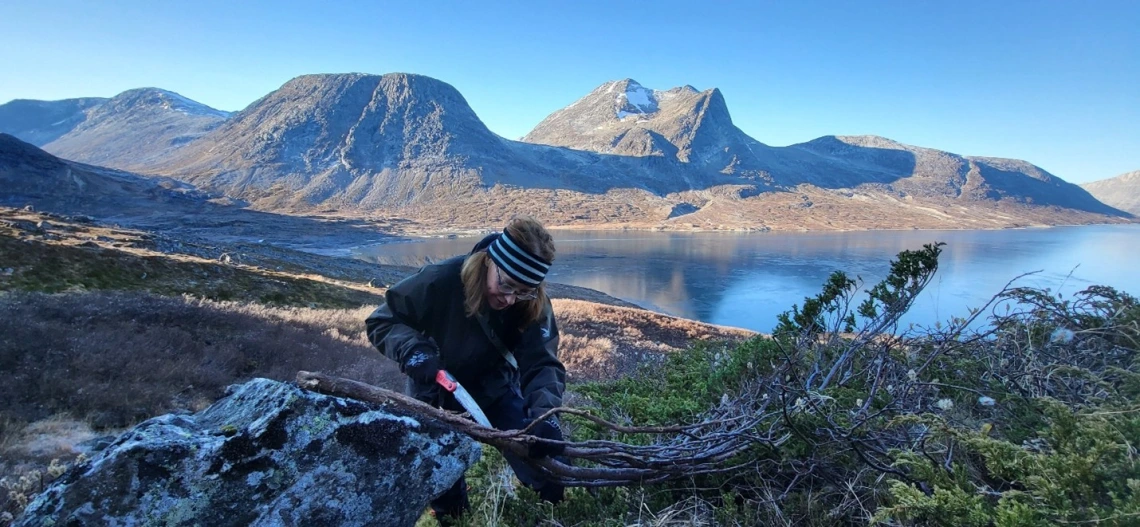Agata Buchwal arrived at the LTRR in January 2025, coming from a post doc in Cambridge UK and Adam Mickiewicz University, in Poznan, Poland. She has long been intrigued by questions that arise from dendrochronology, and in particular, how dendrochronological methods can inform investigations of Arctic terrestrial ecology and climate (she also spent three years doing research in the Alaskan tundra!). She is driven by the knowledge that while “the Arctic” may be considered a single climate regime, the region is not climatically homogenous, and the impacts of climate change vary accordingly. Unfortunately, Arctic climate observations are scarce and records that do exist are short. However, through studying the region’s terrestrial ecology, it is becoming apparent that high-latitude trees and shrubs have great potential to serve as climate proxies across this region.
Agata’s interests and expertise range from tundra shrubs ecology to wood anatomy and climate reconstruction. Her recent work (Buchwal et a. 2025) pioneered the use of blue rings to document not only summer temperatures but the impacts of cooler conditions in different parts of the summer growing season, in both conifer trees and shrubs. Blue rings are anatomical features within growth rings that reflect a lack of lignification due to cold temperatures. In their study of pine trees (Pinus sylvestris) and juniper shrubs (Juniperus communis) at tree line in northern Norway, Agata and colleagues found similar patterns of blue rings in both pines and juniper, although the pines appeared to be more sensitive to cold conditions. This work demonstrated the strong potential for reconstructions of past summer cold events, possibly at the intraseasonal resolution.
Agata’s current research is building on this work by further investigating differences in the ways that blue rings are formed in high-latitude conifers (P. sylvestris) compared to shrubs (J. communis), and using that information to develop long records of summer temperature. This research involves tree/shrub sites across northern Scandinavia. It will take advantage of the fact that shrub remnants that can be used to extend the living tree chronology, in one case, back 800 years. The pine and juniper share a summer temperature climate signal, but the junipers appear to be more resistant to extremes, and record only the most severe cold events. This is likely because the shrub canopy result in a warmer environment, but to date, a reliable comparison of the environments, including a temperature comparison of the shrub canopy versus that of tree’s, has not been made.
The work that Agata has planned for the future will continue to explore quantitative wood anatomy, and soon tree-ring isotopes, to expand the physiological understanding of ring formation in shrubs compared to conifers, and to use this information to develop long records of Arctic climate variability and climate change. Agata and Soumaya Belmecheri, with colleagues at Adam Mickiewicz University, University of Turin, and WSL, recently received proof-of-concept funding to use the LTRR’s new LA-IRMS (see Soumaya’s research highlight in this newsletter) to apply carbon and oxygen isotopes analysis to blue rings in pines and juniper shrubs. Their goal is to learn more about the isotopic response to the stresses ---extreme cold events—that produce blue rings. What is the role of carbon during these stressful conditions? What is the isotopic signal of severe cold events? How are the duration and magnitude of these events reflected in current year and subsequent year isotopes? Agata also hopes to extend her work to high-latitude terrestrial environments in Canada and Greenland (and maybe to high elevation environments as well!).
Beyond her own research, Agata would like to share her love for dendrochronology and the potential it has for exploring environmental questions across multiple disciplines with student everywhere. She hopes to foster curiosity in her students and encourage them to delve deeply into topics that intrigue them, engaging with them through her teaching (including a CURE course in the future; see article on teaching via CURE in the newsletter).
For more on Agata’s work, see:
“Curious ‘Blue Rings’ in Trees Reveal Fiery Volcanic Secrets” in Newsweek: https://www.newsweek.com/blue-rings-trees-shrubs-volcanic-eruptions-norway-2018804
And her recently published paper:
Buchwal A, Matulewski P, Sjöberg Y, Piermattei A, Crivellaro A, Balzano A, Merela M, Krže L, Čufar K, Kirdyanov AV, Bebchuk T, Arosio T and Büntgen U (2025) Blue rings in trees and shrubs as indicators of early and late summer cooling events at the northern treeline.
Frontiers in Plant Science, https://www.frontiersin.org/journals/plant-science/articles/10.3389/fpls.2024.1487099/full

